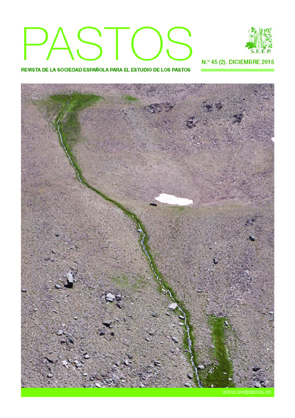INFLUENCIA DE LA CALIDAD DEL TERRENO EN LA RESPUESTA DE LOS PASTOS A LA APLICACIÓN DE FÓSFORO = INFLUENCE OF SOIL QUALITY IN THE RESPONSE OF PASTURES TO THE PHOSPHORUS APPLICATION
Palabras clave:
Biomasa, mejora, superfosfato de cal, digestibilidad, proteína, Biomass, improvement, superphosphate of lime, digestibility, proteinResumen
Resumen
En el suroeste extremeño los pastos son de producción muy irregular y escasa calidad nutritiva. Tradicionalmente los ga- naderos de esta área clasifican las zonas de su finca en malas y buenas, realizando fertilización fosfórica únicamente en parte de las buenas. Con el fin de evaluar la influencia de la calidad del terreno en la respuesta del pasto a la fertili- zación fosfórica, se diseñó un experimento en dos fincas de la comarca de La Serena (Badajoz) consistente en la apli- cación o no de 250 kg ha-1 de superfosfato de cal al 18% en dos zonas diferenciadas según la pendiente, la profundidad y la pedregosidad del terreno. En tres campañas agrícolas, se analizó la composición botánica, la producción, proteína bruta y digestibilidad de materia orgánica del pasto, tanto en invierno como en primavera. La proteína y la digestibilidad del pasto invernal mejoró en la zona mala por la fertilización fosfórica (aumentó de 15% a 16%), así como el porcentaje de leguminosas que aumentó de 20% aa 30%. Por tanto, existe respuesta positiva a la aportación de fósforo en zonas clasificadas por los ganaderos como malas, mostrando potencial de mejora de calidad y composición botánica.
Abstract
In the southwest of Extremadura pastures show a very irregular production and low nutritional value. In this zone, farmers classified their farm’s areas in bad and good, and fertilization with phosphate is made only in good areas. In this study we evaluated the soil quality influence on the pasture improvement when phosphoric fertilizer was used. The experiment was conducted in two farms in the region of La Serena (Badajoz), where the main plot was the quality of the soil differentiated based on slope, depth and stoniness, and the sub-plot was the fertilization. Superphosphate of lime to 18% at a rate of 250 kg ha-1 was applied, having a control area without fertilization. This experiment was replicated in three different agro- nomical years, and the botanical composition of pasture, the production in dry matter, the crude protein and the organic matter digestibility of grass in winter and spring were analyzed. Protein and digestibility of winter grass in bad areas were improved by phosphorus fertilization (increasing from 15% to 16%) and the percentage of legumes changed from 20% to 30%. There is, therefore, a positive contribution of phosphorus in classified areas as bad by farmers, showing them an improvement potential regarding to pasture quality and botanical composition.










